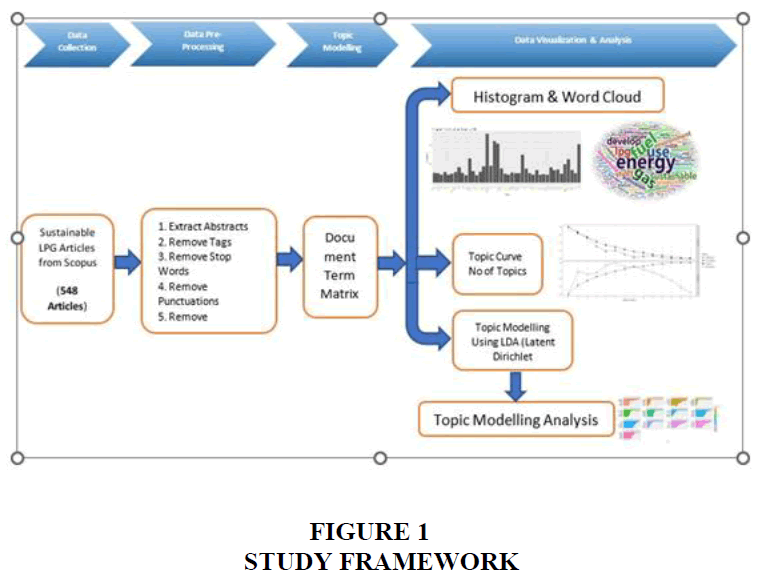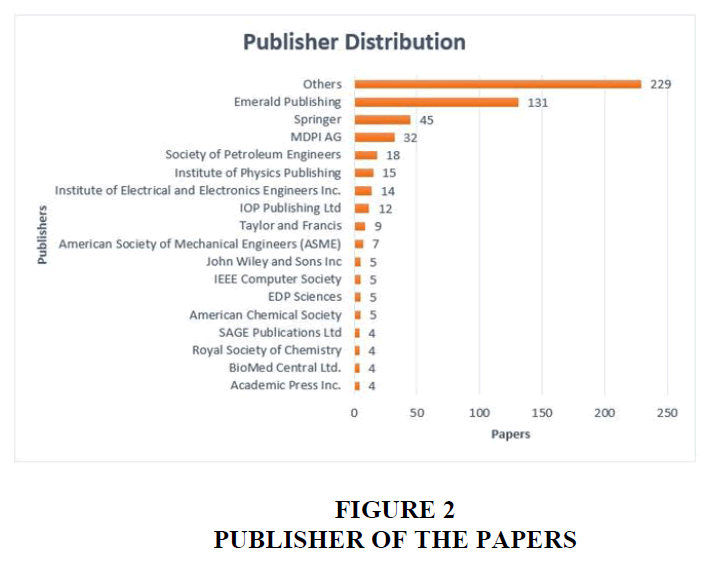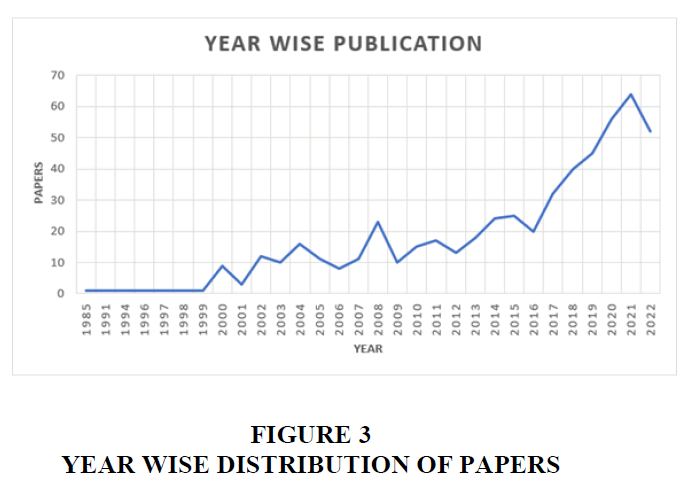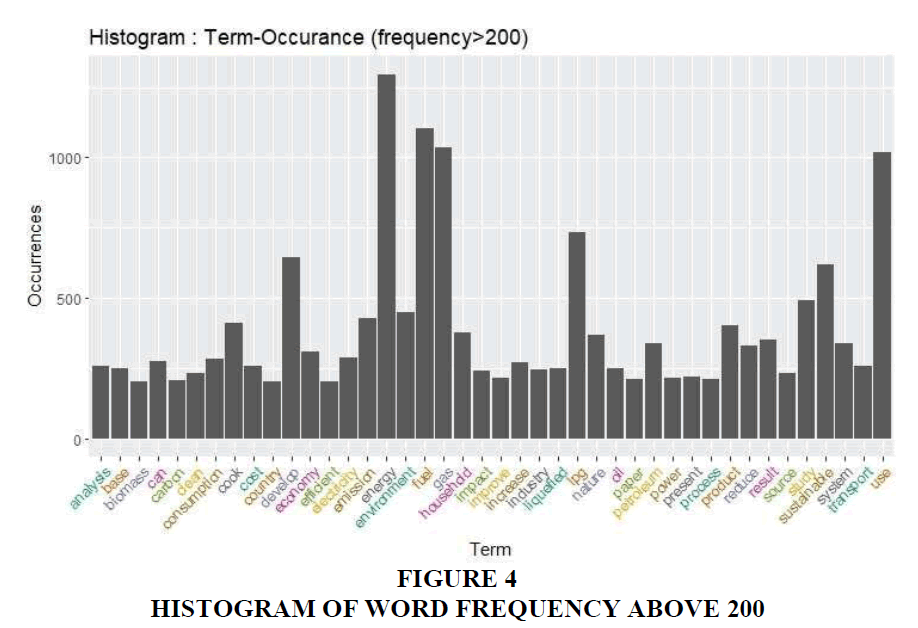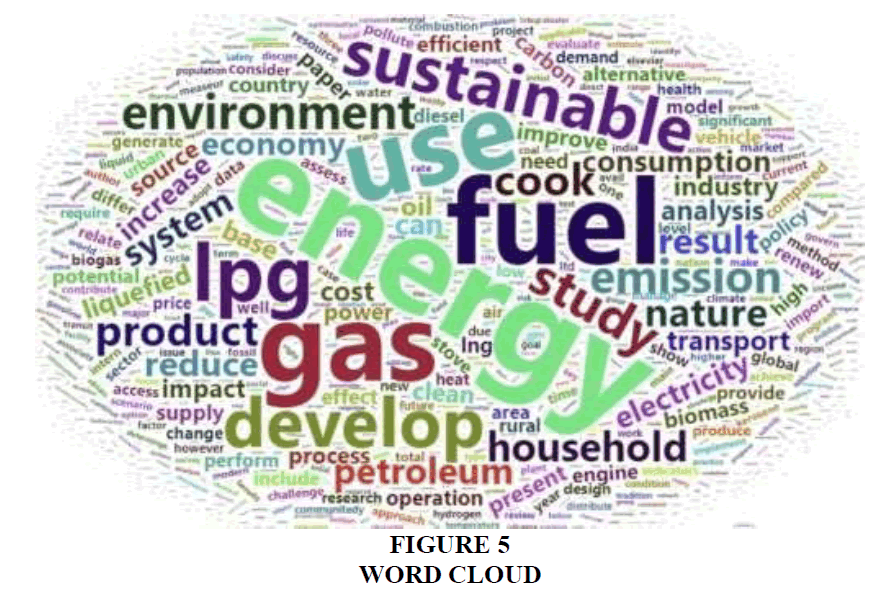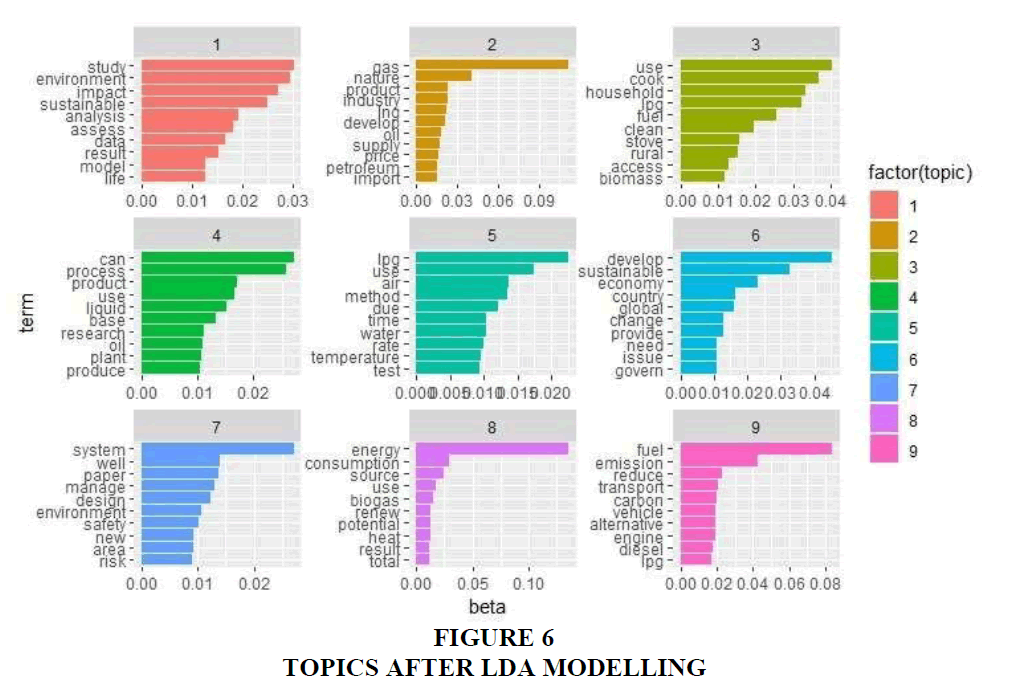Review Article: 2024 Vol: 28 Issue: 2
Decoding Sustainable LPG: A Topic Modeling Study on Emerging Patterns and Practices
Abhijit Deb Roy, Rajiv Gandhi Institute of Petroleum Technology, Amethi
Shrawan Kumar Trivedi, Rajiv Gandhi Institute of Petroleum Technology, Amethi
Debashish Jena, Rajiv Gandhi Institute of Petroleum Technology, Amethi,
Praveen Kumar, Rajiv Gandhi Institute of Petroleum Technology, Amethi
Citation Information: Deb Roy, A., Kumar Trivedi, S., Jena, D., & Kumar, P. (2024). Decoding sustainable lpg: a topic modeling study on emerging patterns and practices. Academy of Marketing Studies Journal, 28(2), 1-23.
Abstract
In the long-term transition to a truly sustainable global energy system, marketing of liquefied petroleum gas (LPG) is increasingly being seen as a "bridging fuel" alongside natural gas. Governments across the world are urging people to utilise LPG as their major source of cooking fuel. This has a major effect on the environment and human health. By minimising the pollution in the kitchen caused by the burning of traditional fuels like firewood, coal, cow dung, and kerosene, it also empowers women. LPG availability and cost were major issues in various nations, and these issues received special attention from the respective governments throughout the world as strategic marketing decisions in the form of subsidies, loans, enhanced supply chains, promotion, regulation, and a focus on health and development. The present global endeavour to reduce indoor pollution centres on the long-term sustainable use of LPG and its adoption as the principal cooking fuel. To analyse the existing research on the topic of “Sustainable LPG”, a thorough literature review on the subject is performed in this work by using a machine learning approach known as "Topic Modelling" with LDA (Latent Dirichlet Allocation). By this investigation, we could zero in on a set of topics that have generated research publications in international journals. In summary, emerging topics pertain to concern for climate change, reduction in pollution, use and adoption of LPG as fuel, impact of LPG usage, various government schemes for promotion of LPG usage etc.
Keywords
Liquefied Petroleum Gas (LPG), Gas, Fuel, Oil and Gas, Petroleum, Sustainability, Energy, Topic Modelling, Latent Dirichlet Allocation (LDA), Machine Learning, Environment, Climate Change, Household Air Pollution (HAP), Marketing Strategy etc.
Introduction
Environmental pollution is one of the burning factors across the world at this moment. By environmental pollution, it means Air Pollution, Water Pollution, Soil Pollution and Sound Pollution etc., which may be due to natural causes as well as man-made causes or both. Excessive burning of fossil fuels, coal, gas, biomass, industrial emissions, mining activities, construction etc. are some of the principal sources of pollution. Vehicular exhaust fume emissions, use of fuel oil and natural gas for heating homes, emission from the coal-fired electricity generation power plants, burning of garbage in landfills etc. contribute to environmental pollution across the world. This results in adverse effect on human health such as respiratory ailments, lung disease, heart disease etc (Poole et al., 2019).
The developed countries are the main source that generates the maximum emissions responsible for the environmental pollution. The consumption of fossil fuels in underdeveloped and developing countries are much lesser in comparison to the developed world International Energy Agency, 2022. However, these underdeveloped and developing countries are equally facing the wrath of environmental pollution. In these countries, household air pollution (HAP) is one of the major risk factors of health hazards whose major impacts are on the women folks working in the kitchen (Gordon et al., 2014). Use of firewood, coal, kerosene, cow-dung etc. contributes mainly towards indoor air pollution (Patel & Kumar, 2020).
Liquefied Petroleum Gas (LPG) is used primarily as a cooking fuel across the globe. Developed countries also use LPG to a large extent for the purpose of heating. To some extent LPG is also used in Industries, Automotives, Agriculture etc. but their share is almost negligible compared to the use of the same as a cooking fuel.
Nations such as India, Ghana, Ecuador, Brazil, Indonesia, Kenya, Peru, Senegal, Sri Lanka etc. have all formulated respective policies for sustainable use of LPG and implemented the use of Liquefied Petroleum Gas (LPG) as a safe cooking fuel alternative (Puzzolo et al., 2020). Governments of these countries have put strong focus on the implementation of the strategy of promoting use of LPG to arrest deforestation, empowering women folks, reducing indoor air pollution. In India, PMUY (Pradhan Mantri Ujjwala Yojana) Scheme is the central government’s initiative through which more than 90 million women below the poverty line from both urban and rural areas were provided LPG connection through various financial benefits and policies. Through the implementation of PMUY Scheme, GOI (Govt. of India) aims to empower women folks, eliminate indoor air pollution, reduce health hazards and overall wellbeing of the women folks in the country (Ahmad et al., 2018) (Chattopadhyay et al., 2021).
To arrest vehicular emissions, dual fuel technologies have been promoted across the world in a big way. Vehicles are encouraged to use LPG (Autogas) as alternate fuel in addition to gasoline. Policies were also formulated to promote use of CNG and LNG as dual fuel in vehicles. The use of LPG across the world has seen its primary use as cooking fuel in kitchens(Richenda Van Leeuwen et al., 2017). LPG is also used to some extent in Agriculture, Industries and in Automotives as fuel whose share of overall demand is less compared to the use in household cooking purpose. The main reason for LPG adoption as cooking fuel is the governmental support by way of subsidies and various other social benefit schemes (Kelly et al., 2014).
World LPG Association (WLPGA), a group consisting of global LPG industry professionals representing the complete LPG value chain, has advocated the sustainable use of LPG in all the sectors. Governments across the globe have also made sustained efforts towards sustainable LPG usage to popularise and increase acceptance of the use of LPG as cooking fuel in kitchens (Wilson et al., 2018).
To understand the work undertaken in a particular area, a literature review on the subject is an integral part of the research process where each of the research papers need to be scrutinised separately. This is tedious, costly, and time-consuming process. With the advent of Machine Learning approaches and using text mining and topic modelling algorithms, literature review can be performed in a fast, cost effective and accurate manner. To study the impact of the sustainable use of LPG across the globe, we have downloaded the papers from Scopus using the keywork “Sustainable LPG” in which we got 548 papers’ abstract downloaded. To analyse the studies undertaken in these papers related to the mentioned topic, we intend to use “Topic Modelling” algorithm “Latent Dirichlet Assignment (LDA)” (Blei et al., 2003) besides others to determine the trends of studies undertaken in the subject.
This current study proposes to answer the following research questions:
RQ1: What are the different factors in the study of Sustainable LPG?
RQ2: How can Topic Modelling assist in understanding the relative importance of various topics in “Sustainable LPG”?
RQ3: How can we evaluate the different research trends undertaken in Sustainable LPG?
Literature Review
Sustainable LPG
The impact of fossil fuels and other sources of energy has given rise to an important concern worldwide called climate change. The burning of the energy sources has impacted the climate to a great extent. We intend to touch upon studies undertaken on this subject across the globe from different country perspective in our subsequent section to understand the sustainable use of LPG and other alternate fuel sources that gives positive impact on concerns of climate change and net zero commitments (United Nations, 2015) across the globe:
(Aizaga et al., 2022) in this study on Ecuadorian companies’ use of fuels and their impact on climate change have found that out of 3 fuels (gasoline, diesel, and LPG), LPG is the least polluting fuel compared to the others and contribute the least to climate change. It has also been seen that with the increase in LPG use, the productivity of the industry using LPG as fuel increases compared to the others.
In Ghana, the use of LPG was promoted by government through LPG promotion program in 1990 to tackle the shortage of cooking fuel and to switch the population from solid fuel to LPG. Subsequently, the government came up with Rural LPG Promotion Program (RLP) in 2013 for the rural population. (Enninful et al., 2022) in this study has given the details of the government initiatives and its success. Due to various reasons, both the initiatives failed but both the schemes showed reduction in health and environmental issues etc. The authors through this paper also studied the feasibility of LPG Cylinder Recirculation Model and its challenges and suggested ways to eradicate the challenges.
In Indian context, (Akter & Pratap, 2022) studied data of 9000 households from 6 energy poor states on adoption of LPG as clean cooking fuel and its benefits for women folks. The study found that with the adoption of LPG, there are health benefits, time saving in cooking and collection of cooking fuel etc. The main benefit of the adoption of LPG is reduction of household air pollution (HAP) and greenhouse gas emissions resulting is health benefits.
Household air pollution (HAP) in Cameroon like other sub-Saharan counties belonging to low- income population is at high risk of respiratory and cardiovascular diseases. (Bruce et al., 2018) (Kypridemos et al., 2020) in their study has outlined the master plan of the Cameroon government to increase the effective us of LPG as a clean cooking energy source to 58% of the population from less than 20% in 2014, which will have substantial health benefits and will impact in tackling climate change.
Like other low income or developing countries, India too is grossly affected by indoor air pollution. In their study on the topic, (Patel & Kumar, 2020) has discussed the health benefits from use of clean cooking fuel such as LPG in household cooking fuel. The sustainable use of LPG through increased adoption of LPG across the country has shown significant benefits but sustainability of the benefits of LPG usage in rural low-income areas is still dismal and require policy interventions towards availability and affordability. Similar is the case in Indonesia where the government had launched an initiative to convert kerosene user to adopt LPG as cooking fuel (Thoday et al., 2018).
In Mexico, to tackle the effect of climate change by promoting effective use of renewable energy, the study by (Díaz-Trujillo et al., 2019) highlighted the concept of carbon pricing to mitigate the effect. In addition to the carbon pricing strategy, it also supports the substitution of LPG with biogas strategy through targeted investment in that sector. The effective formulation of carbon pricing strategy results in a dual effect of investment in biogas sector to tackle the environmental pollution faced by the population.
(Agwu NM, 2015) has outlined that to prevent effects of climate change, LPG use is encouraged among the urban households in Abia State in Nigeria. The paper studied the preference of LPG usage, relationship of availability and adoption of LPG, psychological aspects of adoption of LPG, factor of high cost and adoption etc. The study found that LPG adoption currently was very low and suggested that all necessary policy interventions and investments need to be made to increase the adoption to tackle effects of climate change.
In this study published in The Lancet journal, (Gordon et al., 2014) has highlighted the impact of household air pollution (HAP) in low- and middle-income countries resulting in rise in respiratory diseases. The primary cause of HAP is the burning of Solid fuel such as Crop residue, dung, coal, firewood etc and kerosene. This impacts the very low income, low-income, and middle-income population across the world in developing and underdeveloped countries. To eradicate the effect of HAP, the study suggests the promotion and use of cleaner fuel like liquid petroleum gas (LPG), natural gas, biogas, electricity, solar powered stoves etc.
(Mccracken et al., 2012) in this article published in Global heart has listed the effect of Household Air Pollution (HAP) due to solid fuel use in cardiovascular diseases (CVD) and respiratory illness. Although respiratory illness is the primary fallout of HAP, the study also indicates that CVD also accounts for large number of mortalities due to HAP across the world. The study reiterates the need for policy formation for promotion of fuel-efficient low-emission cooking medium in low-income countries around the world.
Topic Modeling
In our current study of sustainable use of LPG, we intend to use Topic Modelling technique to analyse the studies undertaken in this topic and derive the directions it has taken over the period. Topic Modelling as a subject and Latent Dirichlet Assignment (LDA) model is specifically discussed in the following section underlining the various usage of the techniques, limitations, evolution of the technique etc.:
(Duong et al., 2022) in the study of product return (PR) perspective adopted a hybrid approach of Topic Modelling and bibliometric analysis in classifying the various research directions on the subject. The hybrid approach on the study gave insightful output such as, digitalization, globalization vs localization, multi-layer and multi-channel, customer behaviour and perception.
In this study, (Lind et al., 2022) used topic modelling in multilingual text from data collected for the purpose of comparative communication research. Taking it forward from the paper published by (Maier et al., 2018) where in monolingual communication research in English through topic modelling was done, here the authors used Polylingual Topic Model (PLTM), that bridges the gap among languages in topic research.
(Maier et al., 2022) in this paper also worked upon multilingual text data for topic modelling through a comparative study of use of Machine Translation (MT) and Multilingual Dictionary (MD) prior to passing the data through topic modelling algorithms. The study found both the techniques yield encouraging results in topic modelling output, but they also retained technique specific differences in their results.
(Trivedi et al., 2022) used topic modelling techniques to study the literature related to COVID- 19 pandemic. The number of research articles and related texts related to the topic COVID-19 was huge and hence topic modelling technique was found to be the perfect tool in reviewing the literature in determining the research trends on the subject. A similar study was also done by (Ilyas et al., 2022).
(Rabitz et al., 2021) in this study have taken up climate change as a subject of study from the 3 Lithuanian news media publications between 2017 and 2018 which constitutes 583 articles.
They wanted to establish the domestic and international linkages in the media articles from the articles and have used LDA topic modelling, using which they found that the news articles are heavily internationalized.
(Fresneda et al., 2021) in this study have used structural topic modelling in segmentation of customers by analysing their open ended (OE) response, online customer service via chat or social media interactions, customer reviews, targeted surveys etc. This segmentation yield benefits such as targeted customer service, relevant customer communications, correct customer benefits and service delivery etc.
(Thielmann et al., 2021) in this study for unsupervised document classification used one-class Support Vector Machines (SVM) and Latent Dirichlet Allocation (LDA) topic modelling classifiers as a multi-step classification technique for large dataset. Their study has been able to showcase the benefits of the use of the technique over manual labelling which is time consuming, costly and requires trained and expert manpower.
In this paper by (De la Hoz-M et al., 2021), the authors introduced an open-source application called LDAShiny, which provides a graphical user interface to researcher of scientific literature to review literature using Latent Dirichlet Allocation (LDA) algorithm. This tool gives an easy- to-use interface to the researcher who is not familiar with R programming language.
(Kherwa & Bansal, 2020) in this study has undertaken a thorough review on “Topic Modelling” algorithms such as Latent Semantic analysis (LSA), Non-Negative Matrix Factorization (NNMF), Probabilistic Latent Semantic Analysis (PLSA), and Latent Dirichlet Allocation (LDA). In this empirical study, the authors studied the application of topic modelling in Scientific Research, Bioinformatics, and Social Network Analysis, Software Engineering etc. besides discussing the challenges in the field such as Visualization, Interpretation, Memory Efficiency and Stability.
(Jacobs & Tschötschel, 2019) in this paper have used Topic Modelling in Discourse Analysis. The study has illustrated the compatibility and feasibility of using topic modelling in discourse analysis by limiting the challenges faced in its study and interpretation.
(Pietsch & Lessmann, 2018) in this study analysed the use of different topic modelling algorithms in open ended (OE) responses in market research which otherwise uses labour intensive costly human efforts. The researcher in this study has considered LDA as benchmark and compared the output of 3 short text topic models for OE responses such as Latent Feature LDA (LFLDA), Biterm Topic Model (BTM) and Word Network Topic Model (WNTM). The result of the 4 models showed encouraging result over laborious and error prone human analysis.
(Ambrosino et al., 2018) used Topic Modelling Technique with LDA as a tool to study the evolution of economics and its changing structure from 250846 articles published from 1845 till 2013 in around 188 journals. The study gives the progression of published research of the topic over the period and highlights the change in trend in the research in economics in that period.
In this paper, (Maier et al., 2018) has studied in detail how Latent Dirichlet allocation (LDA) topic modelling can be effectively used in communication research. The paper outlined the 4 stages of topic modelling such as a) pre-processing b) selection of model parameters c) model’s reliability d) interpretation of the result and gives a hands-on user guide of how LDA can be effectively used with best results in the area of research.
In this paper, (Alghamdi & Alfalqi, 2015) carried out a survey on hierarchical probabilistic models called topic modelling, which provides ways to analyse unclassified textual data. Topic modelling is classified into 2 categories – ‘methods of topic modelling’ containing Latent Semantic Analysis (LSA), Probabilistic Latent Semantic Analysis (PLSA), Latent Dirichlet Allocation (LDA), Correlated Topic Model (CTM) and ‘topic evolution model’ containing Topic Over Time (TOT), Dynamic Topic Models (DTM), multiscale topic tomography, dynamic topic correlation detection (DTCM), detecting topic evolution in scientific literature and online topics. The paper discusses all the algorithms and outlines their characteristics and limitations. Similar work is also done by (Ravikumar et al., 2023).
Topic Modelling using R
(Ponweiser, 2012) in this thesis has outlined the practical use of topic modelling using Latent Dirichlet Allocation (LDA) and R Statistical Programming language. The paper uses the practical application of LDA and has shown the implementation of the algorithms in R packages like tm and topicmodels. Implementation of document term matrix (DTM), text pre- processing, Model selection, results of the model execution etc in R is explained at detail in this thesis.
The application of topicmodels package in R Programming language is discussed by (Grün & Hornik, 2011) in this paper. They discussed topic modelling stages and its implementation in R with wide variety of inbuild packages developed over the years.
Methodology
The methodology of our study is depicted in Figure 1 below. The methodology used in this study has primarily four phases, which are a) Data Collection, b) Data Pre-Processing, c) Topic Modelling and d) Data Visualization and Analysis of results.
Data Collection
The data collection for the study was done from Scopus Database using the keyword “Sustainable LPG”. The keyword resulted in total 548 papers, whose Author, Abstract, Title, Keyword, Publisher, and Year of Publications are downloaded in a .CSV file containing 548 rows of data. The Abstract column in the .CSV file is the main column required for this study. The papers belong to the journals such as Elsevier, Francis, and Taylor, MDPI, Emerald etc. Altogether there are 134 distinct journals wherein these papers were published starting from 1985 till 2023 in the collection. Figure 2 below elaborates the Journal wise distribution of the papers in the collection.
Figure 3 below gives us year wise distribution of the papers in the collection. It can be found that maximum papers in the collection are from year 2013 onwards. Starting from 1985 till 2012 there were only 165 papers whereas from 2013 to 2023 there are 383 papers in total. We see that a huge impetus was given on the study of “Sustainable LPG” as a subject in recent years mainly in the last decade.
Data Pre-Processing
The data collected in .csv file contains 6 columns such as “Author”, “Abstract”, “Title”, “Keyword, “Publisher” and “Year of Publications” and having 548 row of data one each for each paper. In this phase of our study, we imported the .csv file into a R Program and extracted the Abstract column into a data-frame. This data-frame was then passed into the pre-processing phase where the content is first converted into lower case. Subsequently, the data is cleaned for all special characters, numbers, punctuations, stop words etc. Next step is application of stemming on the data which reduced a word to its basic form. Post stemming, each of the words are manually checked for its spelling and corrected in the R code. This resulted in a total of 6452 unique words which are 3 characters or more in length.
Topic Modeling
The data cleaning phase has created a collection of words most relevant in the studies undertaken in the collection of data. In this phase, we first converted the cleaned data of abstract column into DTM (Document Term Matrix), which determines the frequency of certain word in the collected data called documents. This DTM is then passed as a parameter to all the topic modelling algorithms for undertaking the study and performing subsequent analysis.
We first created “Topic Curve” by using the DTM using the algorithms formulated by “‘Griffiths2004’, ‘CaoJuan2009’, ‘Arun 2010’, and ‘Deveaud 2014’”. The topic curve gives us the optimum number of topics that can be determined in this study. Figure 4 below is the “Topic Curve” generated for the data set we have in our study which determines that we can have 8- 10 no of optimal topics as part of our analysis of “Sustainable LPG” topic modelling.
We next created the histogram Figure 4 of all words which has frequency of more than 200 in our data collection. We find that word with highest frequency in the data collection are “energy (1297)”, “fuel (1105)”, “Gas (1035)”, “sustainable (621)”, “lpg (735)” etc.
Wordcloud, a graphical representation of frequency of word that gives prominence to words having higher frequency more, is then generated for the collection of words in DTM. Figure 5 below is the wordcloud which also shows words like “energy”, “fuel”, “sustainable”, “lpg”, “gas”, “environment” etc in prominence than that of other words.
Finally, the DTM is passed as parameter to LDA (Latent Dirichlet Allocation) statistical model that classifies text in a document to a particular topic, modelled as Dirichlet distributions. Output to LDA is the set of topics with a set of words within the topic. Figure 6 gives us the graphical output of the topics after passing through the LDA modelling.
Data Visualization and Analysis
Outputs generated by the R-Program gives the topics with cluster of keywords used in those topics. These are the words which occurred in these papers. The LDA gave us the topics with keywords and documents belonging to each of the topics. Figure 7 below gives us the distribution of documents in each of the topics in our collection.
While passing the collection through DTM (Document Term Matrix) it was found that there are 4 papers whose abstract are not available in our collection of 548 papers. Thus, when documents were passed through LDA modelling with k=9 and n=10, data from 544 out of 548 documents were only analysed. The output of the LDA model resulted in 9 topics each having 10 keywords in each.
Analysing each of the topics for its keywords and their inter-relation and weightage, we can determine the research direction under each of the topics. Studying the group of papers individually will give us a better understanding of the research undertaken in each of the topics and the direction of the research and the methodology followed.
Topic Modelling Classifiers
Topic modelling is an unsupervised machine learning natural language processing (NLP) technique that scans and analyses a set of textual data, detecting words and phrases, to list out a set of topics having a set of words that best describes the characteristics of the documents. Topic modelling churns input set of documents into topics containing set of words which determines the meaningful sentiments each group of documents are inferring about.
While using Topic Modelling, researchers need to tackle the following: a) Proper pre- processing of the collected data, b) Proper selection of Modelling parameter including the appropriate number of topics to be generated, c) model’s reliability analysis, d) result analysis and interpretation.
Latent Dirichlet Allocation (LDA):
LDA is an unsupervised machine learning algorithm and statistical model used in topic modelling, which generates topics from the collection of documents based on frequency distribution and variance. It creates the list of topics and list of words incorporated in those topics based on the number of Topics (K) we want to generate and the number of keywords (N) we want to incorporate in each of the topics for our understanding and analysis (Blei et al., 2003).
Based on the output of LDA modelling, it is analysed to put an inference of the topics based on the cluster of words generated in each of the topics.
Data Analysis and Results
In our study, abstract from all the documents were converted into 6960 tokenised words in the pre-processing stage. DTM (Document Term Matrix) is then created from these tokenised words of the collection. From topic curve, we found that there are 8-10 best topics that can be generated. Using the DTM, the LDA (Latent Dirichlet Allocation) algorithm is executed for 2000 iterations to create 9 topics (k=9) with 10 keywords each (n=10). Table 1 below is the list of 9 topics with its 10 keywords each generated as output of LDA model.
| Table 1 Keyword List of Topics | |||||||||
| Topic 1 | Topic 2 | Topic 3 | Topic 4 | Topic 5 | Topic 6 | Topic 7 | Topic 8 | Topic 9 | |
| 1 | study | gas | use | can | lpg | develop | system | energy | Fuel |
| 2 | environment | nature | cook | process | use | sustainable | well | consumption | emission |
| 3 | impact | product | household | product | air | economy | paper | source | reduce |
| 4 | sustainable | industry | lpg | use | method | country | manage | use | transport |
| 5 | analysis | lng | fuel | liquid | due | global | design | biogas | carbon |
| 6 | assess | develop | clean | base | time | change | environment | renew | alternative |
| 7 | data | oil | stove | research | water | provide | safety | potential | vehicle |
| 8 | result | supply | rural | oil | rate | need | area | heat | engine |
| 9 | model | price | access | plant | temperature | issue | new | result | diesel |
| 10 | life | petroleum | biomass | produce | test | govern | risk | total | lpg |
From the output of the LDA model, we also got “ Document to Topic” and “Abstract to Topic Probability” model outputs. Using “Document to Topic” output, we classified the documents in our collection with the topics to classify each of the documents into their respective topics. The summary of number of documents falling under each of the 9 topics and their percentage share of overall numbers are shown in Table 2 below.
| Table 2 Percentage Share of Documents in Topics | ||
| Topics | Papers | % Of Papers in Topic |
| Topic-1 | 40 | 7.35 |
| Topic-2 | 66 | 12.13 |
| Topic-3 | 103 | 18.93 |
| Topic-4 | 44 | 8.09 |
| Topic-5 | 47 | 8.64 |
| Topic-6 | 42 | 7.72 |
| Topic-7 | 48 | 8.82 |
| Topic-8 | 71 | 13.05 |
| Topic-9 | 83 | 15.26 |
| Grand Total | 544 | 100.00 |
For all the nine topics we calculated the weightage of each keyword in it and found out the strength of each word in the topic output from LDA model. The LDA modelling process generated the “Abstract to Topic” probability matrix for all the documents in the scope. Table 3 below represents first 10 rows of the matrix with 544 rows. The columns here in the matrix correspond to each of the 9 Topics as mentioned in Table 1 and Table 2 above.
| Table 3 Abstract to Topic Probability | |||||||||
| V1 | V2 | V3 | V4 | V5 | V6 | V7 | V8 | V9 | |
| 1 | 0.072997 | 0.072997 | 0.043928 | 0.090439 | 0.078811 | 0.043928 | 0.067183 | 0.067183 | 0.462532 |
| 2 | 0.095433 | 0.089298 | 0.205862 | 0.083163 | 0.058623 | 0.138378 | 0.101568 | 0.119973 | 0.107703 |
| 3 | 0.334387 | 0.064244 | 0.050026 | 0.125856 | 0.050026 | 0.083202 | 0.045287 | 0.09268 | 0.154292 |
| 4 | 0.274758 | 0.068237 | 0.030193 | 0.312802 | 0.068237 | 0.062802 | 0.062802 | 0.030193 | 0.089976 |
| 5 | 0.148148 | 0.129369 | 0.068336 | 0.063641 | 0.030777 | 0.152843 | 0.073031 | 0.190402 | 0.143453 |
| 6 | 0.103268 | 0.062092 | 0.050327 | 0.120915 | 0.344444 | 0.091503 | 0.091503 | 0.062092 | 0.073856 |
| 7 | 0.078811 | 0.038114 | 0.072997 | 0.096253 | 0.177649 | 0.084625 | 0.049742 | 0.067183 | 0.334625 |
| 8 | 0.090965 | 0.041514 | 0.398657 | 0.063492 | 0.090965 | 0.118437 | 0.068987 | 0.074481 | 0.052503 |
| 9 | 0.091766 | 0.051587 | 0.114087 | 0.024802 | 0.457837 | 0.078373 | 0.06498 | 0.060516 | 0.056052 |
| 10 | 0.072845 | 0.060396 | 0.388197 | 0.056247 | 0.0355 | 0.089442 | 0.085293 | 0.159982 | 0.052098 |
Each of the row in the table above corresponds to each of the documents and the column values gives the probability of each of the topic being present in each of the document. Considering row 1, we can see that column V9 has the maximum value i.e., 46. 25%, which means that document 1 has 46.25% chances to be about Topic 9. Similarly for row 2, column V3 has the 20.59% probability which is the maximum value. In other words, we can interpret that document 2 has 20.59% chance to be about Topic 3.
Topic Labelling
From the LDA modelling, we have 9 topics (k=9) with 10 keywords (n=10) in each of the topics as shown in Table 1 above. Looking at the keywords in each of the topics, we need to define a suitable name for each of the topic which can define the crux of the study undertaken in the cluster of documents corresponding to each of the topic.
Topic 1: In Topic 1, we have the keywords as “life, data, assess, model, impact, analysis, result, environment, study, sustainable” where most dominant words are Environment, Sustainable, Study, Analysis etc. These dominant words show that this topic is related to research on “Environment and Sustainable Energy Sources.” Row 1 in Table 4 below gives the wordcloud and year wise distribution of papers in this topic which consists of 40 documents.
| Table 4 Wordcloud & Year Wise Publication of Topics | ||||
| Topics | Keywords | # of Papers | WordCloud | Year wise Paper Distribution |
| 1 | life data assess model impact analysis result environment study sustainable |
40 | 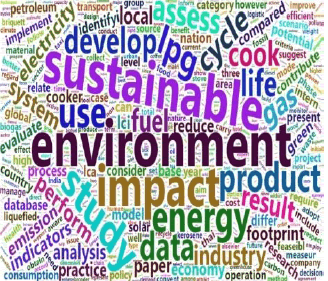 |
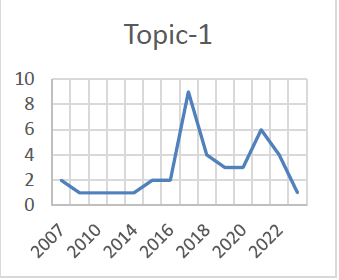 |
| 2 | price lng supply industry oil petroleum nature product develop gas |
66 | 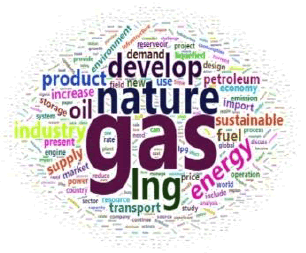 |
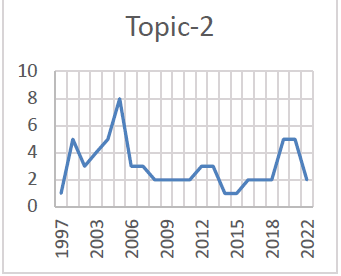 |
| 3 | access rural stove biomass clean household cook lpg use fuel |
103 | 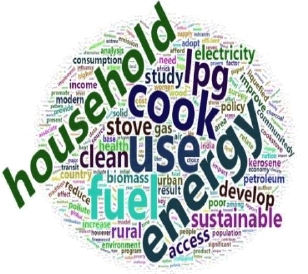 |
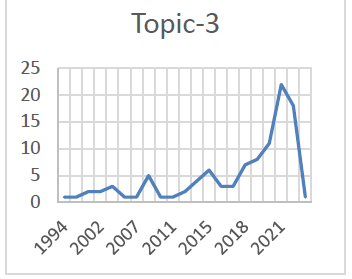 |
| 4 | plant liquid produce research process oil base can product use |
44 | 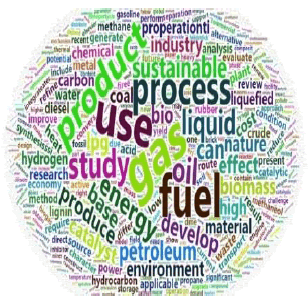 |
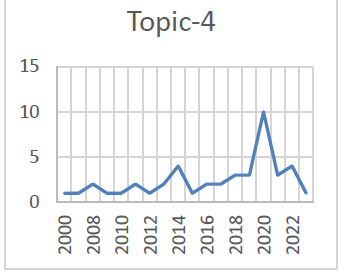 |
| 5 | temperature test rate due water time method air lpg use |
47 | 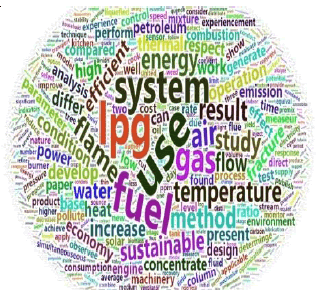 |
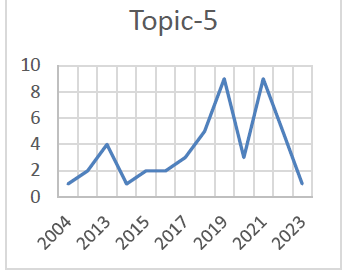 |
| 6 | govern issue global change provide need country economy sustainable develop |
42 | 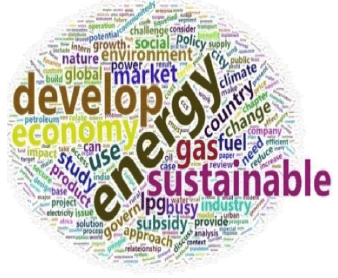 |
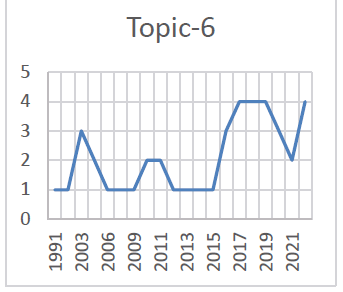 |
| 7 | risk safety manage new design well area paper system environment |
48 | 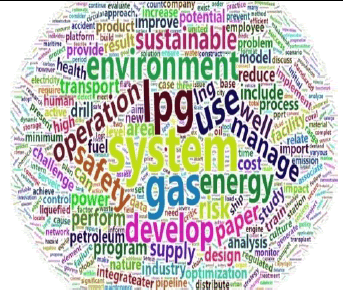 |
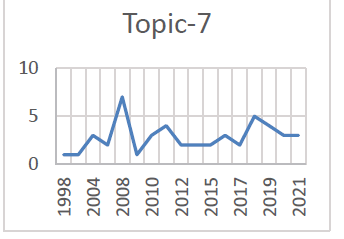 |
| 8 | total biogas heat renew potential source consumption result use energy |
71 | 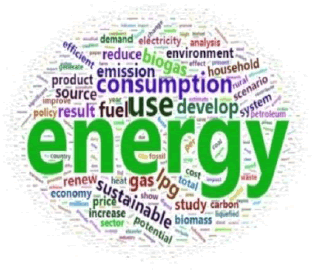 |
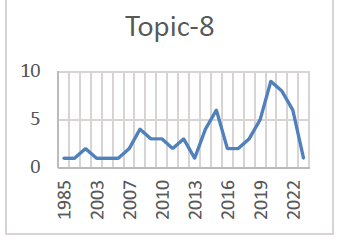 |
| 9 | diesel alternative vehicle engine carbon transport reduce emission lpg fuel |
83 | 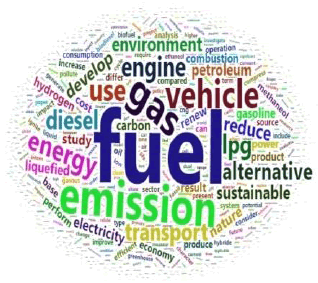 |
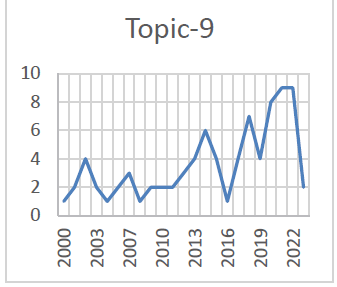 |
Topic 2: In Topic 2, we have the keywords as “price, lng, supply, industry, oil, petroleum, nature, product, develop, gas” where most dominant words are Gas, Develop, Product, Nature etc. These dominant words show that the research undertaken in the related research papers under this topic are related to “Natural Gas as Sustainable Energy Product.” Row 2 in Table 4 above gives the wordcloud and year wise distribution of papers in this topic consisting of 66 documents.
Topic 3: In Topic 3, we have the keywords as “access, rural, stove, biomass, clean, household, cook, lpg, use, fuel” where the dominant words in the cluster are LPG, Fuel, Cook, Household, Clean, Rural etc. The combination of the keywords shows that the research in this topic is related to “Clean Cooking Fuel as Sustainable Alternatives”. Row 3 in Table 4 above gives the wordcloud and year wise distribution of papers in this topic consisting of 103 documents.
Topic 4: In Topic 4, the keywords are “plant, liquid, produce, research, process, oil, base, can, product, use” where the dominant words are Use, Product, Research etc. The study under this topic can be defined as “Sustainable Product Research”. Row 4 in Table 4 above gives the wordcloud and year wise distribution of papers in this topic which consists of 44 documents.
Topic 5: In Topic 5, the keywords are “temperature, test, rate, due, water, time, method, air, lpg, use” having the dominant words as LPG and Use. In this cluster topic, we can thus define that study to be “Uses of LPG”. Row 5 in Table 4 above gives the wordcloud and year wise distribution of papers in this topic which consists of 47 documents.
Topic 6: In Topic 6, the keywords are “govern, issue, global, change, provide, need, country, economy, sustainable, develop”. Analysis of the combination of keywords in the topic relates to “Sustainable Energy Development”. Row 6 in Table 4 above gives the wordcloud and year wise distribution of papers in this topic which consists of 42 documents.
Topic 7: The keywords are “risk, safety, manage, new, design, well, area, paper, system, environment”. The keywords depict the study as “Sustainable Energy – Risk, Safety & Environment”. Row 7 in Table 4 above gives the wordcloud and year wise distribution of papers in this topic which consists of 48 documents.
Topic 8: In Topic 8, the keywords are “energy, consumption, source, use, biogas, renew, potential, heat, result, total”. Analysing the combination of keywords and their weightage, we can figure out that the study undertaken in this topic cluster relates to “Forecasting Energy Consumption”. Row 8 in Table 4 above gives the wordcloud and year wise distribution of papers in this topic which consists of 71 documents.
Topic 9: In Topic 9, the keywords are “fuel, emission, reduce, transport, carbon, alternative, vehicle, engine, diesel, lpg”. The combination of the keywords in this topic relates to study of “Carbon Emission Reduction in Transportation”. Row 9 in Table 4 above gives the wordcloud and year wise distribution of papers in this topic which consists of 83 documents.
Discussion
Using the LDA (Latent Dirichlet Allocation) statistical model on the downloaded data set for “Sustainable LPG”, we got 9 different topics with 10 keywords each. We also got the classification of all the papers into each of the topics generated by LDA. Table 5 below gives us the “Names” of each of the topics and keywords mapped in the previous section of this document. In this section, we are going to elaborate each of the topic and discuss the subject of research undertaken under each of the topic.
| Table 5 Topic Names | ||||
| Topic | Topic Name | Keywords | No of Papers | Citation |
| Topic-1 | Environment and Sustainable Energy Sources | life, data, assess, model, impact, analysis, result, environment, study, sustainable |
40 | (Kimambo, 2007) (Kulkarni, 2019) |
| Topic-2 | Natural Gas as Sustainable Energy Product | price, lng, supply, industry, oil, petroleum, nature, product, develop, gas | 66 | (Kutcherov et al., 2017) (Motalo et al., 2020) |
| Topic-3 | Clean Cooking Fuel as Sustainable Alternatives | access, rural, stove, biomass, clean, household, cook, lpg, use, fuel | 103 | (Jana & Bhattacharya, 2017) (Kizilcec et al., 2022) |
| Topic-4 | Sustainable Product Research | plant, liquid, produce, research, process, oil, base, can, product, use | 44 | (Natakaranakul et al., 2021) (Gautam et al., 2020) |
| Topic-5 | Uses of LPG | temperature, test, rate, due, water, time, method, air, lpg, use | 47 | (Gupta et al., 2022) (Horesh et al., 2019) |
| Topic-6 | Sustainable Energy Development | govern, issue, global, change, provide, need, country, economy, sustainable, develop | 42 | (Farouq & Al-Obaidi, 2022) (Sadiyah et al., 2021) |
| Topic-7 | Sustainable Energy – Risk, Safety & Environment | risk, safety, manage, new, design, well, area, paper, system, environment | 48 | (Hirst et al., 2008) (Akyuz & Celik, 2015) |
| Topic-8 | Forecasting Energy Consumption | energy, consumption, source, use, biogas, renew, potential, heat, result, total | 71 | (Jingchao & Kotani, 2012)(Rivera- González et al., 2020) |
| Topic-9 | Carbon Emission Reduction in Transportation | fuel, emission, reduce, transport, carbon, alternative, vehicle, engine, diesel, lpg |
83 | (Baek et al., 2021) (Kapilan & Prabhu S, 2022) |
Environment and Sustainable Energy Sources
The collection of articles under this topic is predominantly concerned about the use of sustainable energy sources and its impact on environment. The topic here revolves around the sustainability of energy sources in day-to-day life across the globe where researchers were able to showcase the use of various sustainable energy sources to minimize the impact of climate change by reducing harmful greenhouse gas emissions (GHG). Environmental impact due to pollution is one area of study where researchers tend to undertake extensive study. Use of various fuel types and sources of pollution is studied to analyse the impact. (Singh et al., 2014) in their paper has done assessment of different fuel sources as cooking fuel and its impact of environment and health. As per their study, LPG usage has 15 to 18% lower environment impact than kerosene. Using solid fuel such as coal and dung has highest impact of emissions. Biogas and charcoal are found to be sustainable source of fuel other than LPG in preventing environmental impact due to climate change and emissions. (Lanfranchi et al., 2018) in their study has found that biomass sources derived from vineyards in Sicily has the potential to replace LPG as fuel source which will have positive impact on effects of climate change. (Kimambo, 2007) in their study in Sub-Saharan African countries have found that use of solar cookers has the best environmental impact where firewood is the main source of cooking fuel and has huge environmental impact. The study has found that adoption of LPG as alternate fuel for cooking is economically very expensive.
In this topic of study, it is primarily focussed on the environmental impact due to various emissions such as household emissions, vehicular emissions etc. The study intends to find alternative energy source for cooking fuel, vehicular fuel which has lower emission rate. Adoption of LPG as sustainable fuel primarily as a cooking fuel has greater impact on environment and health.
Development of Natural Gas as Sustainable Energy Product
The papers in this topic are mostly related to Natural Gas and its development as a sustainable alternative to petroleum products and lpg. The adoption of natural gas as energy source will have a positive impact on environment and in reduction of GHG emissions. As an alternative to fossil fuel which has huge impact on greenhouse gas emissions, electric battery, ammonia, hydrogen, biofuel, liquefied natural gas (LNG), liquefied petroleum gas (LPG) etc. are some of the alternatives that can be promoted. (Koilo, 2020) in this paper has studied the use of alternate fuel sources in Norwegian maritime industry specially LNG and LPG and studied their positive impact on the environment with an objective to reduce greenhouse gas emissions in line with the UN 2015 agenda of sustainable development goals by 2030 (UNDP, 2015). Study by (Kutcherov et al., 2017) about global energy market and dominion of natural gas has outlined the growth of sustainable energy sources in times to come. With the discovery of natural gas reserves and development of infrastructure required to explore usage of natural gas, most of the major economies around the globe have been moving towards gas economies. Alternative fuel, renewable energy, and sustainable fuel sources are one of the main agenda of almost all governments to achieve the sustainable development goals and to reduce the impact of greenhouse gas emissions. In that direction, most of the economies are moving towards adoption of natural gas as one of their primary fuel sources which gives huge positive impact towards sustainable development and positive direction towards climate change. Optimization and Supply chain is one of the important factors in implementation of the natural gas economies (Kaligis et al., 2019). In that direction, to have a positive direction towards sustainable development goals of 2030, (Motalo et al., 2020) studied the qualitative aspects of natural gas (NG), liquefied natural gas (LNG) and liquefied petroleum gas (LPG) and its impact on environment.
This topic of study revolved around natural gas as a sustainable source of energy world over in attaining the sustainable development goals. To achieve the goal by all major economies, who are otherwise the major GHG emitters, natural gas has been promoted as a major energy source to have sustainable energy objective. Huge developments related to infrastructure, storage, distribution etc are being undertaken in these economies and large amount of funds are getting spent in this direction.
Clean Cooking Fuel Alternatives
The collection of papers in this topic revolves around the subject of clean household cooking fuel alternatives around the world. Papers mostly talk about fuel such as LPG, Electric stoves, Solar Stoves etc. as a sustainable medium for household energy requirements which will eliminate the harmful effects of household air pollution (HAP) mainly responsible for respiratory and cardiovascular ailments. To achieve the UN Sustainable Development Goals 2030 (SDG2030) target no 7.1 which states “by 2030, ensure universal access to affordable, reliable and modern energy services”, governments of developing countries across the globe are working on replacing solid fuel for cooking with LPG. This is also going to result in reduction of emission of greenhouse gasses. (Hollands & Daly, 2023) in their study has outlined how adoption of LPG has dual impact of availability of energy and climate mitigation as an objective. Household pollution due to solid fuel burning is a major source of health impacts across the globe and will have positive impact if solid fuel gets replaced by LPG. For achieving this, governments across the globe requires to implement policy which caters to both energy and climate change as an objective. A study in this direction in Sub-Saharan African countries by (Kizilcec et al., 2022) have outlined different aspects of adoption of LPG, solar home system, electric cooker with respect to affordability, availability, family size etc. All of them (LPG, solar home system, electric cooker) are clean cooking alternatives to the solid fuel being extensively used in that region and has huge potential of transition to the alternatives. The study by (Maurya et al., 2022) (Jana & Bhattacharya, 2017) on Indian perspective have also found LPG, Biogas and Gasifier stoves as viable alternatives to solid fuel for cooking but illustrated that they are expensive and unaffordable to the local population. They also have suggested policy driven interventions by government to promote the alternative fuel to solid fuel for cooking.
The study of clean cooking fuel alternatives as replacement to solid fuels are manyfold. The urban population has mostly been using LPG as cooking fuel and has electric cookstoves as a possible clean fuel alternative. The rural populaces who are mostly using solid fuel sources, Kerosene etc. are slowly moving to cleaner LPG as an alternative cooking fuel. However, in most of the countries LPG gas availability, affordability and supply chain of LPG distribution is a major concern in adoption and sustainable use of LPG.
Sustainable Product Research
In this collection of papers, the primary theme is the development of renewable products through extensive research like biogas, bio-crude, bio-methanol, bio-alkane, dimethyl ether, or bio-lpg etc. into sustainable fuel for household cooking or transportation purposes to be used in place of the petroleum products, solid fuel etc. Possibilities of sustainable materials conversion into fuel through research and product development is the goal towards environmental sustainability and climate change goals including net zero. In the paper by (Yang et al., 2014), comprehensive study was undertaken in this area. Conversion of natural gas into methane as feedstock for transportation fuel, biogas from landfills into methane, biogas into compressed natural gas (CNG) and liquefied biogas (LBG), catalytic conversion of methane into alcohols and liquid hydrocarbon fuels, production of hydrogen from methane via reforming process etc. have been studied in the paper. There are technologies available through research to convert biogas into transportation fuel such as bio-CNG and bio-LBG which have very less greenhouse gas and particulate matter emissions in comparison to the traditional transportation fossil fuel. Since biogas is generated from waste as transportation fuel, it gives an added advantage in respect to waste management across the globe. (Gautam et al., 2020) in their study have discussed about the current technology for conversion of waste biomass into bio-methanol and discussed the processes and requirements to make this an economically viable alternative source of cleaner fuel. Greenhouse gasses such as CO and CO2 emissions are enormous from coal and petroleum fired thermal power plants which are released into atmosphere by these plants. These greenhouse gases can be captured and converted into dimethyl ether (DME) using catalysts, reactors, and separators. There are technologies available for the conversion of greenhouse gases into DME and further research are underway by several organizations across the globe to simplify the process, but study by (Mondal & Yadav, 2019) has outlined the difficulties and factors such as cost intensive as primary hinderances to its implementation. To convert CO2 into liquefied petroleum gas (LPG) through direct synthesis process using catalysts and combination of metals called CZZA (copper/zinc oxide/zirconium/alumina) is studied in the paper presented by (Natakaranakul et al., 2021).
There are enormous efforts given into research on technology development for the development of sustainable and clean fuel products from sources such as biomass, greenhouse gases, emissions etc. Although there are technologies available for such conversion, but their commercial utilization is yet to be realised. More such research on this field is underway across the globe and we can expect that with the sustainable development goal objective, we may soon see several such technologies exploited commercially with economic and environmental gains.
Uses of LPG
With sustainable use of energy as a primary aim like reduction of household air pollution and reduction in emission of greenhouse gases (GHG), collection of papers under this topic mainly caters to various efficient usages of LPG besides cooking fuel for kitchen such as in dual-fuel vehicles, refrigerants, in agriculture etc. In the study by (Zuliani et al., 2011), high temperature proton exchange membrane fuel cell (HTPEM) is fed with liquefied petroleum gas (LPG) using a compact steam reformer to convert energy of fuel into electricity. The resultant process is highly efficient having very low greenhouse gas emissions. Study by (Horesh et al., 2019) has shown the use of LPG in agriculture in onion farming for control of weeding. LPG is used here for flaming both during pre and post emergence weed control method and are safe for use as it has no adverse impact on the onion yields. In the article by (Abdul Mujeebu et al., 2013) and collection of articles from (Gupta et al., 2022), there were studies in the direction of LPG cookstoves and burners which yield better efficiencies.
LPG which is primarily being used as cooking fuel also has other uses such as in metal cutting, weeding in agriculture, dual-fuel in transportation industry, fuel-cell technology etc. The technology for its diverse usage is varied and it being low emission fuel has comparatively less impact on environment and climate change. There are quite a few researches undertaken to develop efficient cookstoves for LPG and other modes of energy used in household cooking. The research in this area focusses on efficiency of the fuel used and the emissions it emanates due to the burning of the fuel.
Sustainable Energy Development
To evolve the energy basket into a sustainable energy mix in-sync with the environmental issues, several innovative products are being developed such as city gas distribution of natural gas replacing lpg, reticulated LPG system in buildings etc. Most of the countries are dependent on LPG import to fuel their demand of domestic consumption. Due to the extreme volatility of prices in international markets for petroleum products, import of these products becomes an uncertain and costly proposition compounding with the supply chain. Transportation of bulk and packed LPG constituting the entire supply chain is of utmost challenge. In most of the countries where LPG has been promoted to be used as domestic cooking fuel, the supply chain issues concerning transportation of LPG to the end-users is of paramount importance. To tackle this issue, alternative methods of distribution and innovative supply chain solutions are adopted. One such innovation is city-gas distribution where primarily LNG is distributed through a mesh of pipelines across a city to each of the households as fuel for kitchens. LPG is also used at some places in-place of LNG in the city gas distribution. However, LPG is alternatively used as a feedstock for such a distribution channel is a reticulated system where a centralised bank of cylinders is packed together in a multi-storied apartments and gas is distributed using a mesh of pipelines connected to the centralized bank for use of LPG in kitchens in that apartment. This is a newer business model of gas distribution and most of the countries around the globe are adopting it as a solution for distribution of cleaner fuel for kitchens. In the study by (Sadiyah et al., 2021) from Indonesian city gas distribution perspective, it was analysed that through implementation of city gas distribution system, dependence on LPG import could be reduced thereby utilizing the reserve of natural gas available within the country. Major challenges discussed in the paper are that city gas distribution is huge capital intensive and requires government interventions in investment and proper legislation and strategy decisions which were lacking. (Farouq & Al-Obaidi, 2022) studied the feasibility of gas distribution pipeline in Iraq and its economic considerations in installation, adoption, and maintainability over the period.
This new business model of city gas distribution and reticulation system for LPG is a step in the right direction for achieving sustainable energy goals. However, this is mostly concentrated in urban areas as of date in the developing and under-developed countries. Government policies and interventions are making inroads for city gas distribution towards smaller cities and towns, but the rural population are still dependant on the traditional distribution network for some time to come. The success of these developments depends on the cost of setting up of the pipeline network and its associated infrastructure needed to complete the setup coupled with the adoption of the service by the population.
Sustainable Energy – Risk, Safety & Environment
Papers in this topic relates to evaluation of risks in energy operations such as production and transportation; health & safety measures taken for the environment conservation and reduction in emissions. Various innovative ways have been developed over the period in this direction towards health & safety measures. Handling of any petroleum products is hazardous and more so in case of gaseous products such as LPG and LNG etc. to make these products available to the end customers relentlessly over a period, an extensive and efficient network of supply chain is needed. This setup of the supply chain should also be designed considering health and safety considerations in mind. Risks associated with the supply chain must be assessed regularly and necessary provisions for safety need to be setup accordingly. Environmental risks are also associated with the energy supply chain and needed attention from the governments and corporations working in this field. Sustainable Development Goal mandates that all associated risks aversions methods must be in place to tackle environmental needs so that any sort of degradation and harm to environment (land, water, and air) must be tackled accordingly. Risks associated to human life connected to handling of the operations of all these hazardous materials are also to be in place. (Akyuz & Celik, 2015) in their paper have highlighted the risk associated with storage and handling of LPG while transportation of bulk LPG through marine bulk carriers and necessary safety measures needed to prevent any accidents and loss of life. (Hirst et al., 2008) in their study in Yemen has highlighted the impact of marine biology in setting up of LNG terminal in Gulf of Aden and measures taken to transplant corals away from the LNG terminal construction site to preserve the environment. (Asopa et al., 2021) conducted a study to highlight the impact of technology, such as IoT, can have in mitigating climate change measures with respect to the usage of energy in buildings. Their study found that using the IoT technology can have a 20% reduction in energy usage thereby having a positive impact of emission and climate change. (Zulkifli Abdul Rashid et al., 2011) is their paper has outlined the risks associated with the transportation of hazardous materials such as LPG. They have analysed the transportation of LPG by tankers through road and its associated risk of accidents, impact on environment and human loss of life.
While energy requirement across the globe is ever increasing, the operation of these hazardous materials involves risk to lives and impact on environment. Various SOPs are in place for handling these materials but still risks associated with it cannot be redeemed. Continuous innovation towards averting any accidents and harm to environment and human life need to be put in place and all concerned with the business need to be putting their efforts in place in tackling any such eventualities.
Forecasting Energy Consumption
In this topic, there is a mix of papers, but dominant ones are related to the forecasting of energy consumption demand across sectors which also considers the environmental impact because of fossil fuel consumption. Demand forecasting of energy requirement is a sphere of study on its own and require continuous innovation and updation as energy consumption pattern changes over time. Forecasting depends on factors such as seasonality, demography, urban vs rural, consumption pattern, availability, price etc. Factors such as transportation growth, growth in economy, incentives in the market economy, household fuel market dynamics are some of the factors that impact the forecasting of energy demand. Forecasting the domestic household energy requirement for consumption in kitchen is a field on its own. Consumption of various fuel associated with household fuel requirement is studied. As most of the emerging economies are dependent on import of fuel such as LPG and LNG used primarily in kitchen, an advanced prediction goes down well in planning and fulfilling the demand. It is seen from economies such as China, India, Brazil etc that there is an exponential growth in demand of such products which are mostly met through imports, a forecasting of the consumption in days to come is need of the hour. (Jingchao & Kotani, 2012) and (Han et al., 2022) have both studied the consumption patterns of energy in day to day live in China. The aspects they studied are urban vs Rural populations need of energy and how that are met. They also discussed the energy requirement of aging population vs the younger population in the country and their energy needs. A similar study is also done with respect to the developing economies by (Weiss de Abreu et al., 2021), where the author conducted a similar study from Brazilian context. This study catered to the entire spectrum of energy basket including household energy requirements primarily for cooking and touched upon aspects of sustainable energy usage policy from the government in that direction. (Rahman et al., 2021) in their paper have undertaken a similar study from a rural sector in Bangladesh where wood as fuel is primarily used. Abundant availability of wood from nearby forests and high cost of alternative fuel such as LPG has made the population continue with wood fuel as source of their energy needs. (Rivera-González et al., 2020) in their paper have studies the energy requirement in transport sector in Ecuador. Their study has concluded that Diesel and Petrol will continue to be the main energy requirement in Ecuador in the transportation sector and requires sustainable energy policy from the government to arrest the greenhouse gas emissions and environmental pollution it impacts.
Although demand prediction of energy requirement is a continuous process without which this extremely complex supply chain cannot sustain its demand fulfilment, the same need to be reviewed from time to time as several factors alter the energy mix requirement. A forward planning is a must in this sector considering the volatility of the energy market. The environmental aspects also need to be factored in while planning and forecasting the energy needs.
Carbon Emission Reduction in Transportation
In this collection of articles under this topic, between mixes of papers the dominant subject is the carbon emission and measures taken for reducing the same to minimize its environmental effects in transportation sector. The papers discuss about mixing of renewable products with conventional fuel in reducing the emission as also prospects of renewable fuels in high emission sectors like transportation etc. Environmental pollution because of energy usage especially by transportation sector is of utmost concern. The emission of greenhouse gasses and particulates such as nitrogen and sulphur etc pollute the environment. Sustainable energy usage is the buzz word currently as world in moving towards NetZero and achieving sustainable energy goals 2030. Various measures in that direction are being promoted so that we can achieve the desired level of reduction in carbon emissions necessary. Studies by (Baek et al., 2021) (Kapilan & Prabhu S, 2022); (Cinar et al., 2020); (Li & Loo, 2014); (Liu et al., 2023). have all worked towards technology innovation towards engine design so that it can emit less carbon and other particulates. Their study also touched upon modification of the engine so that it can be fuelled by cleaner fuel such as LPG and biofuels such as biodiesel, bioethanol etc. The primary objective of all these studies is the reduction of emissions of greenhouse gasses to the atmosphere.
Climate change and greenhouse gas emissions are of the utmost concern across the globe. All possible and necessary measures to reduce the emissions are undertaken for which all concerned across the globe are committed. Sustainable goals are set to be achieved by all in reduction of emissions of greenhouse gases and make our world a better place to live.
Implications of Study
Practical Implications
The findings in this study led to aspects such as impact of various fuel used in our day-to- day life has huge implications on health, environment, and economy. Sustainable use of LPG in sectors such as household cooking reduces impact of greenhouse gases (GHG) and household air pollution (HAP) to a large extent. This has resulted in several governmental schemes to encourage adoption of LPG as fuel in place of solid fuel and kerosene. In various other sectors, wherever possible, renewal energy products such as biogas, electric cookers (Gould et al., 2018), ethanol/methanol etc are used in place of LPG and other petroleum products to reduce emissions and reduce the environmental impact. Sustainability and arresting environmental impact due to the use of traditional fuel in our day-to-day life is a big concern and large numbers of studies have been undertaken in this subject across the world. Global dependence on petroleum products will remain as economies around the world are in an upswing specially in the emerging economies. Environmental concerns however remain; and necessary steps by government and populations to handle the concerns must be devised adequately.
This study of the “Sustainable LPG” using Topic Modelling algorithms have opened various avenues in the research space related to energy space in an around LPG such as renewable energy, various energy mix methods in reduction of emissions, innovative ways to tackle climate change, health safety and environmental concerns, women empowerment, and wellbeing etc. Topic modelling have clearly assisted us in finding the various facets of research undertaken so far in this space. Some of the interesting research trend that could be explored further in-depth are a) Emission reduction in transportation sector, b) energy demand forecasting, c) Environment and Energy, d) Reduction of GHG and HAP, e) Policy Formulation etc (Quinn et al., 2018).
Managerial Implications
The concrete and effective steps that could be adopted to tackle the sustainable use of LPG as well as various other emission efficient energy sources is the policy formulation and adoption through forums such as the UNDP, World Bank, ADB, OPEC etc for sustainable energy usage in reduction of GHG and emissions for the benefit of health and environment.
Conclusion and Frame Work
Liquefied petroleum gas (LPG) is one of the most popular fuels used for cooking, heating, transportation, and industrial use across the world. LPG usage is mainly in the household cooking in most of the developing economies. In developed economies, LPG is mainly used for heating purpose. LPG in developing economies is mainly marketed by the respective governments to arrest the impact of harmful emissions due to the usage of solid fuel in household cooking. Sustainable LPG usage is promoted in the developing economies particularly in countries like India, Ghana, Indonesia, Sub-Sharan countries, Latin American countries etc to obtain several benefits some of which are : a) reduction of greenhouse gas emission, b) eliminate use of solid fuel in kitchens, c) obtain health benefits due to reduced emissions, d) empowerment of women folks in household decision making, e) saving of time in collection of fuel etc . However, there are several concerns in adoption of Sustainable LPG such as availability, high cost, inadequate supply chain, market volatility etc. As an alternative to LPG is sectors such and transportation, household cooking, industries, agriculture etc, there have been a spurt in adoption of Natural Gas and renewable sources such as biogas, ethanol, methanol etc, whose primary objective is to reduce carbon emissions and improve health and environment (Ozier et al., 2018). Although a huge impetus is given to renewal energy sources to meet our energy needs. It is but not practically possible to stop using petroleum products in our daily life. Even if renewal energy generation and consumption is on the rise, with the expansion of economies across the globe specially in emerging economies such as India, China, Brazil, Indonesia etc fuel import and consumption is on a rise with the expansion of the economies. This impacts the environment of these countries to a large extent. The government of these economies is working overtime to arrest the environment impact on the population through policies such as PMUY in India. In future work about sustainable LPG, we may also study aspects such as: a) LPG production from renewal sources, b) Reduce greenhouse gas emission from LPG production, c) LPG conservation, d) LPG Recycling, e) LPG alternatives etc. By adopting these approaches, we can have LPG as a reliable and sustainable fuel source meeting our energy need which will also help in a great extent in environment conservation and reduction of harmful gas emission.
References
Aizaga, M., Celi, E., & Toasa, R. (2022). Use of fuels in the productivity of ecuadorian companies: Assessment of their impact on climate change. Sustainability, 14(13), 7649.
Indexed at, Google Scholar, Cross Ref
Akter, S., & Pratap, C. (2022). Impact of clean cooking fuel adoption on women’s welfare in India: The mediating role of women’s autonomy. Sustainability Science, 17(1), 243-257.
Indexed at, Google Scholar, Cross Ref
Akyuz, E., & Celik, M. (2015). Application of CREAM human reliability model to cargo loading process of LPG tankers. Journal of Loss Prevention in the Process Industries, 34, 39-48.
Indexed at, Google Scholar, Cross Ref
Asopa, P., Purohit, P., Nadikattu, R.R., & Whig, P. (2021). Reducing carbon footprint for sustainable development of smart cities using IoT. In 2021 Third International Conference on Intelligent Communication Technologies and Virtual Mobile Networks (ICICV). (361-367). IEEE.
Indexed at, Google Scholar, Cross Ref
Baek, S., Kim, K., Cho, J., Myung, C. L., & Park, S. (2021). Assessment of gaseous, particulate, and unregulated emissions from diesel compression ignition and LPG direct injection spark ignition minibus vehicles under the world harmonized vehicle cycle on a chassis dynamometer. Fuel, 294, 120392.
Indexed at, Google Scholar, Cross Ref
Bekoe, M.A., & Enninful, A.N. Ghana LPG Cylinder Recirculation Model: The Opportunities and Challenges.
Blei, D.M., Ng, A.Y., & Jordan, M.I. (2003). Latent dirichlet allocation. Journal of machine Learning research, 3, 993-1022.
Chattopadhyay, M., Arimura, T.H., Katayama, H., Sakudo, M., & Yokoo, H.F. (2021). Subjective probabilistic expectations, household air pollution, and health: Evidence from cooking fuel use patterns in West Bengal, India. Resource and Energy Economics, 66, 101262.
Indexed at, Google Scholar, Cross Ref
Cinar, G., Eldamanhory, A., Akansu, S.O., Fil, H.E., & Ilhak, M.I. (2020). Experimental study on an SI engine fuelled by LPG/acetylene mixtures. International Journal of Automotive Technology, 21, 1323-1331.
Indexed at, Google Scholar, Cross Ref
De Abreu, M.W., Ferreira, D.V., Pereira Jr, A.O., Cabral, J., & Cohen, C. (2021). Household energy consumption behaviors in developing countries: A structural decomposition analysis for Brazil. Energy for Sustainable Development, 62, 1-15.
Indexed at, Google Scholar, Cross Ref
De, A., Aggarwal, S.K., Kushari, A., & Runchal, A.K. (2022). Advances in Energy and Combustion: Safety and Sustainability. A. K. Gupta (Ed.). Springer Nature Singapore.
Indexed at, Google Scholar, Cross Ref
Díaz-Trujillo, L.A., Tovar-Facio, J., Nápoles-Rivera, F., & Ponce-Ortega, J.M. (2019). Effective use of carbon pricing on climate change mitigation projects: analysis of the biogas supply chain to substitute liquefied-petroleum gas in Mexico. Processes, 7(10), 668.
Indexed at, Google Scholar, Cross Ref
Farouq, A.A., & Al-Obaidi, B.H. (2022). Sustainability in the design of liquefied petroleum gas systems used in buildings. Journal of the Mechanical Behavior of Materials, 31(1), 248-255.
Indexed at, Google Scholar, Cross Ref
Gautam, P., Upadhyay, S.N., & Dubey, S.K. (2020). Bio-methanol as a renewable fuel from waste biomass: current trends and future perspective. Fuel, 273, 117783.
Indexed at, Google Scholar, Cross Ref
Gordon, S.B., Bruce, N.G., Grigg, J., Hibberd, P.L., Kurmi, O.P., Lam, K.B.H., & Martin, W.J. (2014). Respiratory risks from household air pollution in low and middle income countries. The lancet Respiratory medicine, 2(10), 823-860.
Indexed at, Google Scholar, Cross Ref
Han, X., Wei, C., & Cao, G.Y. (2022). Aging, generational shifts, and energy consumption in urban China. Proceedings of the National Academy of Sciences, 119(37), e2210853119.
Indexed at, Google Scholar, Cross Ref
Hirst, R., Sutton, C., & Chaîneau, C.H. (2008). Coral transplantation, an innovative measure in the frame of environmental impact mitigation. In SPE International Conference and Exhibition on Health, Safety, Environment, and Sustainability? (pp. SPE-111475). SPE.
Indexed at, Google Scholar, Cross Ref
Hollands, A.F., & Daly, H. (2023). Modelling the integrated achievement of clean cooking access and climate mitigation goals: An energy systems optimization approach. Renewable and Sustainable Energy Reviews, 173, 113054.
Indexed at, Google Scholar, Cross Ref
Horesh, A., Igbariya, K., Peleg, Z., & Lati, R.N. (2019). LPG Flaming—A Safe Post-Emergence Weed Control Tool for Direct Seeded and Bulb Onion. Agronomy, 9(12), 786.
Indexed at, Google Scholar, Cross Ref
Indexed at, Google Scholar, Cross Ref
Jana, C., & Bhattacharya, S.C. (2017). Sustainable cooking energy options for rural poor people in India: an empirical study. Environment, Development and Sustainability, 19, 921-937.
Indexed at, Google Scholar, Cross Ref
Jingchao, Z., & Kotani, K. (2012). The determinants of household energy demand in rural Beijing: Can environmentally friendly technologies be effective?. Energy Economics, 34(2), 381-388.
Kaligis, D. A., Chotima, C., & Patawaran, N. (2019). Modeling simulation application Monte Carlo method for LPG distribution. In IOP Conference Series: Earth and Environmental Science, 343(1), 012242.
Indexed at, Google Scholar, Cross Ref
Kapilan, N. (2022). Studies on Mahua Oil Biodiesel as the Sustainable Fuel in Compression Ignition Engine. Acta Technologica Agriculturae, 25(2), 85-91.
Kimambo, C.Z.M. (2007). Development and performance testing of solar cookers. Journal of energy in Southern Africa, 18(3), 41-51.
Kizilcec, V., Perros, T., Bisaga, I., & Parikh, P. (2022). Comparing adoption determinants of solar home systems, LPG and electric cooking for holistic energy services in Sub-Saharan Africa. Environmental Research Communications, 4(7), 072001.
Indexed at, Google Scholar, Cross Ref
Koilo, V. (2020). Energy efficiency and green solutions in sustainable development: Evidence from the Norwegian maritime industry. Journal Problems and Perspectives in Management.
Indexed at, Google Scholar, Cross Ref
Kutcherov, V.G., Bessel, V.V., & Lopatin, A.S. (2017). The paradigm shift in the global energy market: domination of natural gas. Proceedings of the 17th International Multidisciplinary Scientific Geoconference SGEM, 2017, 813-820.
Indexed at, Google Scholar, Cross Ref
Kypridemos, C., Puzzolo, E., Aamaas, B., Hyseni, L., Shupler, M., Aunan, K., & Pope, D. (2020). Health and climate impacts of scaling adoption of liquefied petroleum gas (LPG) for clean household cooking in Cameroon: a modeling study. Environmental health perspectives, 128(4), 047001.
Indexed at, Google Scholar, Cross Ref
Lanfranchi, M., Schimmenti, E., & Giannetto, C. (2018). Economic analysis and energy valorisation of by-products of the wine supply chain: the case of the ‘Mamertino wine PDO’. International Journal of Environmental Studies, 75(5), 800-811.
Indexed at, Google Scholar, Cross Ref
Liu, X., Zhu, R., Jin, B., Zu, L., Wang, Y., Wei, Y., & Zhang, R. (2023). Emission characteristics and light absorption apportionment of carbonaceous aerosols: A tunnel test conducted in an urban with fully enclosed use of E10 petrol. Environmental Research, 216, 114701.
Indexed at, Google Scholar, Cross Ref
Maurya, P., Palanisamy, M., Mahalingam, A.K., Kaushik, L.K., & Ramalingam, A. (2022). Performance, economic and pilot studies on canister-based methanol stove for household cooking application. Energy for Sustainable Development, 66, 117-124.
Indexed at, Google Scholar, Cross Ref
McCracken, J.P., Wellenius, G.A., Bloomfield, G.S., Brook, R.D., Tolunay, H. E., Dockery, D.W., & Rajagopalan, S. (2012). Household air pollution from solid fuel use. Global heart, 7(3), 223.
Indexed at, Google Scholar, Cross Ref
Mondal, U., & Yadav, G.D. (2019). Perspective of dimethyl ether as fuel: Part II-analysis of reactor systems and industrial processes. Journal of CO2 Utilization, 32, 321-338.
Indexed at, Google Scholar, Cross Ref
Motalo, V., Stadnyk, B., Motalo, A., & Likhnovsky, I. (2020). Hydrocarbon gases quality: Impact on sustainable development goals and environment. Sustainable Production: Novel Trends in Energy, Environment and Material Systems, 105-129.
Indexed at, Google Scholar, Cross Ref
Mujeebu, M.A., Abdullah, M.Z., & Zuber, M. (2013). Experiment and simulation to develop clean porous medium surface combustor using LPG. J Ther Sci Technol, 33, 55-61.
Natakaranakul, J., Thongkam, M., Li, H., Suchamalawong, P., Tsubaki, N., & Vitidsant, T. (2021). Direct Synthesis of Liquefied Petroleum Gas from Carbon Dioxide Using a Copper/Zinc Oxide/Zirconia/Alumina and HY Zeolite Hybrid Catalyst. ChemistrySelect, 6(28), 7103-7110.
Indexed at, Google Scholar, Cross Ref
Oteh, O.U., Agwu, N.M., Nwaogu, E.N., & Nto, C.P. (2015). Mitigating climate change and determinants of access to liquified petroluem gas (LPG) among urban households in Abia State, Nigeria. Journal of Earth Science & Climatic Change, 6(5), 1.
Indexed at, Google Scholar, Cross Ref
Patel, U., & Kumar, D. (2020). The Indian Energy Divide: Dissecting inequalities in the energy transition towards LPG. (401).
Indexed at, Google Scholar, Cross Ref
Poole, J.A., Barnes, C.S., Demain, J.G., Bernstein, J.A., Padukudru, M.A., Sheehan, W.J., & Nel, A.E. (2019). Impact of weather and climate change with indoor and outdoor air quality in asthma: A Work Group Report of the AAAAI Environmental Exposure and Respiratory Health Committee. Journal of Allergy and Clinical Immunology, 143(5), 1702-1710.
Indexed at, Google Scholar, Cross Ref
Puzzolo, E., Cloke, J., Parikh, J., Evans, A., & Pope, D. (2020). National scaling up of LPG to achieve SDG 7: Implications for policy, implementation, public health and environment.
Quinn, A.K., Bruce, N., Puzzolo, E., Dickinson, K., Sturke, R., Jack, D.W., & Rosenthal, J.P. (2018). An analysis of efforts to scale up clean household energy for cooking around the world. Energy for Sustainable Development, 46, 1-10.
Indexed at, Google Scholar, Cross Ref
Rahman, M.H., Kitajima, K., & Rahman, M.F. (2021). Spatial patterns of woodfuel consumption by commercial cooking sectors within 30 km of Lawachara National Park in northeastern Bangladesh. Energy for Sustainable Development, 61, 118-128.
Indexed at, Google Scholar, Cross Ref
Rashid, Z.A., El-Harbawi, M., Sherif, A.A., & Shariff, A.R. (2011). Risk analysis for the road transportation of hazardous chemicals in Malaysia: A methodology. In 2011 National Postgraduate Conference, 1-6. IEEE.
Indexed at, Google Scholar, Cross Ref
Rivera-González, L., Bolonio, D., Mazadiego, L.F., Naranjo-Silva, S., & Escobar-Segovia, K. (2020). Long-term forecast of energy and fuels demand towards a sustainable road transport sector in Ecuador (2016–2035): A LEAP model application. Sustainability, 12(2), 472.
Indexed at, Google Scholar, Cross Ref
Sadiyah, H., Iswandi, E., Thamrin, S., Sasongko, N.A., & Kuntjoro, D.D. (2021). Challenges and prospects of developing city gas to reduce imported LPG in Indonesia. IOP Conference Series: Earth and Environmental Science, 753(1), 012027.
Indexed at, Google Scholar, Cross Ref
Singh, P., Gundimeda, H., & Stucki, M. (2014). Environmental footprint of cooking fuels: a life cycle assessment of ten fuel sources used in Indian households. The International Journal of Life Cycle Assessment, 19, 1036-1048.
Indexed at, Google Scholar, Cross Ref
Thoday, K., Benjamin, P., Gan, M., & Puzzolo, E. (2018). The Mega Conversion Program from kerosene to LPG in Indonesia: Lessons learned and recommendations for future clean cooking energy expansion. Energy for Sustainable Development, 46, 71-81.
Indexed at, Google Scholar, Cross Ref
Yang, L., Ge, X., Wan, C., Yu, F., & Li, Y. (2014). Progress and perspectives in converting biogas to transportation fuels. Renewable and Sustainable Energy Reviews, 40, 1133-1152.
Indexed at, Google Scholar, Cross Ref
Zuliani, N., Taccani, R., & Radu, R. (2011). Experimental and Theoretical Performance Analysis of a High Temperature PEM Fuel Cell Fed with LPG Using a Compact Steam Reformer. In International Conference on Fuel Cell Science, Engineering and Technology, 54693, 991-998.
Indexed at, Google Scholar, Cross Ref
Received: 02-Aug-2023, Manuscript No. AMSJ-23-13848; Editor assigned: 03-Aug-2023, PreQC No. AMSJ-23-13848(PQ); Reviewed: 29-Sep-2023, QC No. AMSJ-23-13848; Revised: 20-Dec-2023, Manuscript No. AMSJ-23-13848(R); Published: 02-Jan-2024
